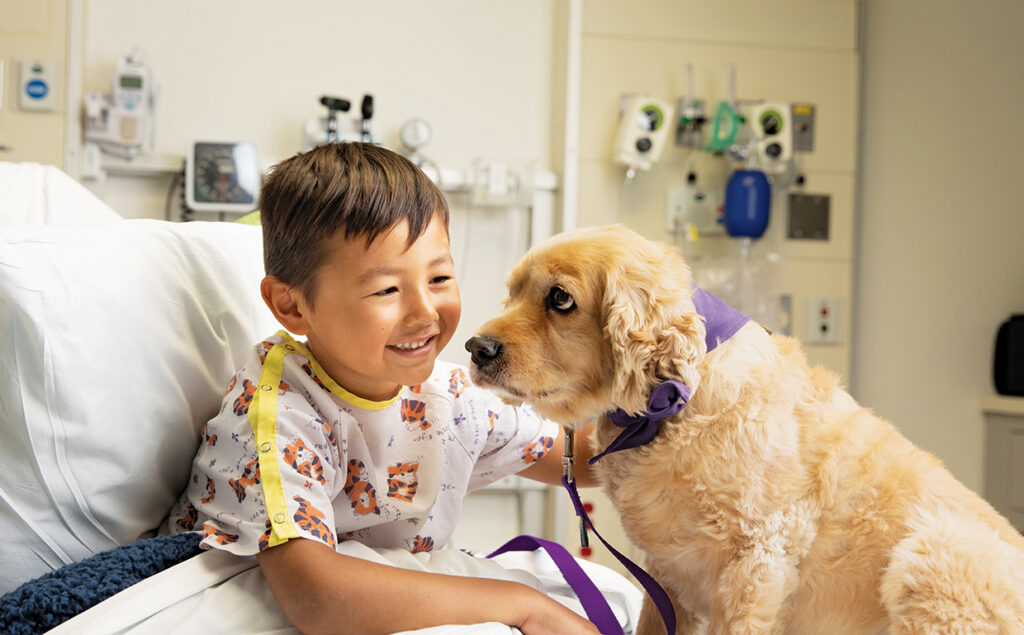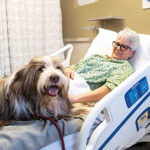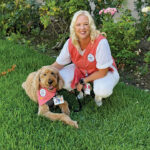Feature
Companions in Care: The Healing Role of Hospital Therapy Animals
How furry friends comfort and delight patients — and nurses!

HOSPITALS MAY FEEL OVERWHELMING — full of quick-paced clinicians, beeping and chiming alarms, bright lights, and hard flooring that even the best Danskos can’t soften.
Within that clinical cacophony, a hospital therapy dog can be a calm and healing presence, offering comfort through an unconditional human-animal bond. The benefits can be profound — and they aren’t limited to only patients!
 HENRY MAYO “Our therapy dog program began over 25 years ago. Sandy Dubin, who trains our therapy dog handlers and is the handler of our beloved bearded collie Reese, has been volunteering here for 24 years! We now have 16 wonderful therapy dogs, and even one therapy bird.”
HENRY MAYO “Our therapy dog program began over 25 years ago. Sandy Dubin, who trains our therapy dog handlers and is the handler of our beloved bearded collie Reese, has been volunteering here for 24 years! We now have 16 wonderful therapy dogs, and even one therapy bird.”
Complementing Traditional Care
Hospital therapy dog programs are a subset of what is known as animal-assisted intervention (see sidebar) where a trained dog offers support for a patient’s wellbeing.
Kate Buhrmaster, manager of the Amerman Family Foundation Dog Therapy Program at Children’s Hospital Los Angeles (CHLA), says therapy dogs enhance care by “supporting the general hospital experience of a patient.”
Further, the dogs help with “creating an environment that offers respite and de-stressing opportunities to family members, visitors, nurses, doctors, and all employees.”
Buhrmaster says therapy dogs assist patients at CHLA in a variety of ways. For example, she says, “A patient who needs to ambulate more might walk laps holding the dog’s leash. A patient who is anxious about a treatment in our neuro clinic might be escorted to and from, and supported throughout, by a dog, making it easier for the patient to receive the care they need.”
“We look at our patients as whole people. What gives them pain, what gives them happiness?” says Jeannie Meyer, RN, MSN, CCRN, CCNS, PCCN, ACHPN, a palliative care clinical nurse specialist at UCLA Health. “These dogs are the perfect manifestation of holistic care.”
 MLK Community Healthcare “¡COMO TE LLAMAS! Our animal therapy program is curated by our Employee Wellbeing team, and includes Ollie the goldendoodle, Mochi the 4-lb teacup maltipoo … and Dulce Canela, the therapy llama! They help to reduce anxiety and depression every time they visit.”
MLK Community Healthcare “¡COMO TE LLAMAS! Our animal therapy program is curated by our Employee Wellbeing team, and includes Ollie the goldendoodle, Mochi the 4-lb teacup maltipoo … and Dulce Canela, the therapy llama! They help to reduce anxiety and depression every time they visit.”
Benefits of Therapy Dogs
Danica Ryan, RN, MSN, CPN, CPHON, a nurse at the Cancer and Blood Disease Institute at CHLA, says she’s seen great responses from her patients working with therapy dogs.
“There was a patient recently seen in the clinic who got chemo,” Ryan says. “She was a teen, not talking, upset at having to be there. It was a challenge. Nothing was working. A Golden Retriever named Goldie came in and stayed in the room for the IV chemo.”
The dog’s presence had a huge impact on the patient. She “changed into a different person,” Ryan recalls. “She was smiling. That dog had such an impact on her. She was able to relax.”
 VENTURA HOSPITAL “Peter and his 4-year-old flat-coat goldendoodle Dalphiena have been volunteering here for six months. Dalphiena loves to visit each nurses station for behind-the-ear scratches.”
VENTURA HOSPITAL “Peter and his 4-year-old flat-coat goldendoodle Dalphiena have been volunteering here for six months. Dalphiena loves to visit each nurses station for behind-the-ear scratches.”
Research on Patient Wellbeing
Researchers have studied patient responses to therapy dogs in various settings, including inpatient psychiatry, pediatrics, emergency, intensive care, oncology, palliative, and end-of-life care.
There have also been studies involving patients with dementia, strokes, or heart failure, or who are recovering from surgeries and other procedures.
Some of the benefits of pet therapy include:
- Improved mental health through reduced boredom, loneliness, and isolation
- Lowered blood pressure and increased motivation for walking and movement
- Increases in oxytocin and decreases in cortisol levels when petting a dog
- Decreased pain and pain-related anxiety in patients with brain tumors
- Improved ability to share memories and laugh in patients with dementia
- Decreased pain and stress in the emergency setting.
 USC VERDUGO HILLS “USC Verdugo Hills Hospital offers animal therapy through the nonprofit Love On 4 Paws. Volunteer Alannah Isherwood and her 6-year-old Australian Cattle Dog mix Gracie visit adults and special-needs children.”
USC VERDUGO HILLS “USC Verdugo Hills Hospital offers animal therapy through the nonprofit Love On 4 Paws. Volunteer Alannah Isherwood and her 6-year-old Australian Cattle Dog mix Gracie visit adults and special-needs children.”
Palliative Care
Therapy dogs can be particularly beneficial in palliative care. Meyer helped to launch the Palliative Pups program at UCLA Health, part of UCLA People-Animal Connection. She recalls a touching story about a patient who had transitioned to end-of-life care and was supported in his last moments by Frank, a Golden Retriever.
“We thought he was going to be unresponsive,” Meyer says. “The family was there and asked for a dog. Frank came and was lifted very gently onto the bed. Frank curled up next to the man. Then, the man reached up and put his arm around the dog. He died that way. It was just beautiful.”
Palliative Pups volunteers and therapy dogs also work with dying patients who do not have anyone at their bedside for support, as part of the No One Dies Alone (NODA) program.
 PIH HEALTH “We established our pet therapy program in 2001. Kona-licious (Kona to her friends) is a Pet Partners-certified 4-year-old Yorkshire terrier who visits patients and families in both inpatient and outpatient care areas, from the ED to radiation/oncology.”
PIH HEALTH “We established our pet therapy program in 2001. Kona-licious (Kona to her friends) is a Pet Partners-certified 4-year-old Yorkshire terrier who visits patients and families in both inpatient and outpatient care areas, from the ED to radiation/oncology.”
Comforting Staff as Well
Staff reap the benefits of therapy dogs too. At CHLA, Ryan explains, “There’s a program called Paws and Relax, which is available weekly for staff. If a nurse is stressed, they can spend 10 to 15 minutes with a dog on their lap, which changes their whole day.”
Meyer says that at UCLA Health, “There have been some days when the dogs hardly make it to the patient’s rooms because the nurses and the staff will stop them and want to pet them and hug them. Some of the nurses have cried with them. It gives me goosebumps when I think about it.”
A 2005 pilot study found that a short visit with a therapy dogs significantly decreased cortisol (stress hormone) levels in healthcare workers.
 HUNTINGTON HEALTH “Dogs have been a part of our hospital volunteer program since 1984. We have a total of 18 teams who visit patients and employees throughout the hospital. Karey Spidell and her goldendoodle Beau comfort patients in our rehab and acute care units.”
HUNTINGTON HEALTH “Dogs have been a part of our hospital volunteer program since 1984. We have a total of 18 teams who visit patients and employees throughout the hospital. Karey Spidell and her goldendoodle Beau comfort patients in our rehab and acute care units.”
Therapy Dog Training
Therapy dogs are handled by volunteers registered with organizations such as Pet Partners or Alliance of Therapy Dogs. Both the dogs and their handlers must undergo thorough training in order to register for hospital work.
Dogs who do therapy work must be obedient and have an appropriate demeanor, and handlers must be able to communicate therapeutically with patients while constantly monitoring their dogs.
Handlers also need to routinely monitor their dog’s health and hygiene, and must practice infection control to keep humans and dogs healthy.
 CASA COLINA “We have three highly regarded canines, known as Bailey, Kessel, and Ohana, who provide therapy and warmth for patients at both Casa Colina Hospital and the Casa Colina Traditional Living Center.”
CASA COLINA “We have three highly regarded canines, known as Bailey, Kessel, and Ohana, who provide therapy and warmth for patients at both Casa Colina Hospital and the Casa Colina Traditional Living Center.”
When They’re Not Appropriate
Therapy dogs are not appropriate for all hospital situations. For instance, handlers and therapy dogs don’t visit patients in isolation because of the risk of infection transmission.
Some people may become nervous around dogs, while others may be allergic. Handlers must obtain consent before every dog visit to help avoid unwanted interactions such as these.
Another potential problem is that a patient may become emotionally attached and not want to let the animal leave, or may become distressed when the visit is over. Handlers should be prepared to address such situations.
“The volunteers are very respectful,” Ryan says. “When we’re changing a dressing, [the dogs] cannot be present. The pet therapy handlers tell the kids they can come back and spend more time with them afterward.”
Benefits Go Beyond Medicine
Hospital therapy dogs help support families, patients, and staff alike. The dogs’ warm, soft, furry presence provides a welcomed respite from hospital stresses, and handlers undergo thorough training to ensure safety and deal with unexpected situations.
These four-legged visitors help make even the roughest days better. “They are nothing but a blessing,” Ryan says.
ROBIN FILLNER, RN, BSN, CMSRN, is an oncology nurse and health writer who specializes in issues of wellness, mental health, and nutrition.
In this Article: Mental and behavioral health, Self-Care and Wellness






